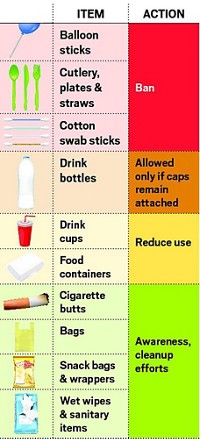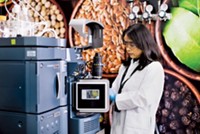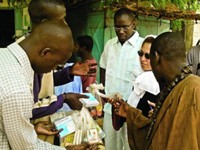Advertisement
Grab your lab coat. Let's get started
Welcome!
Welcome!
Create an account below to get 6 C&EN articles per month, receive newsletters and more - all free.
It seems this is your first time logging in online. Please enter the following information to continue.
As an ACS member you automatically get access to this site. All we need is few more details to create your reading experience.
Not you? Sign in with a different account.
Not you? Sign in with a different account.
ERROR 1
ERROR 1
ERROR 2
ERROR 2
ERROR 2
ERROR 2
ERROR 2
Password and Confirm password must match.
If you have an ACS member number, please enter it here so we can link this account to your membership. (optional)
ERROR 2
ACS values your privacy. By submitting your information, you are gaining access to C&EN and subscribing to our weekly newsletter. We use the information you provide to make your reading experience better, and we will never sell your data to third party members.
Environment
Tenth Birthday For A Consumer Champion
European lab focuses on developing ways that countries can foster consumer safety and health
by Patricia L. Short
December 15, 2008
| A version of this story appeared in
Volume 86, Issue 50

THE PRESENCE of genetically modified organisms (GMOs) in human food and animal feed. The use of nanotechnology in consumer products. Chemical tests on animals. All are hot topics in the European Union these days.
And how the EU, through the European Commission's Joint Research Center (JRC), tackles these issues while supporting legislation and standard-setting for consumer health and protection was the focus of a rare daylong briefing for a dozen journalists late last month.
The journalists, including this one, spent the day at Ispra, the home base of JRC's Institute for Health & Consumer Protection, or IHCP. Ispra, a 410-acre collection of facilities nestled on the southeast shore of Lake Maggiore, in northern Italy, is the largest of the five sites within JRC's realm.
The seminar, which marked IHCP's 10th anniversary, included visits to labs that address most of the institute's research interests. These interests range from new nanotechnology-derived ingredients in cosmetics and personal care products to more established materials, such as food wraps and the polymeric gaskets in jar lids.
IHCP also took the opportunity to detail its recent restructuring program. Elke Anklam, director of IHCP, explained that the new organizational structure is designed to more closely cluster the institute's various scientific competencies. "Our mission is to support our colleagues in Brussels and in the member countries with technical assistance," Anklam said. "We are a reference center of science and technology for the EU."
In the briefing, Anklam outlined the institute's broad range of responsibilities; they include the following:
◾ The validation of new testing methods to improve the regulation of chemicals, cosmetics, and medical products while reducing reliance on animal testing.
◾ The validation of methods for detecting GMOs in food and feed.
◾ Development and validation of analytical methods to detect contaminants in food packaging materials.
◾ Characterization of emissions from indoor sources such as carpets, paints, and other products using IHCP's "Indoortron," a life-size room with precise control of temperature, humidity, ventilation, and air quality.
◾ Combating fraud in the wine sector, such as mislabeling, sugaring, and watering.
◾ Assessing the interaction of nanomaterials with biomolecules by using in vitro testing on cell models that represent different routes for human exposure.
Roughly three-quarters of the institute's work, Anklam said, centers on the basics of validation, standardization, reference-material certification, benchmarking, and compliance checking to underpin policy implementation. For example, IHCP is reviewing methods for detecting melamine in food and feed to develop tests for the contaminant that can be used throughout the EU. It also is developing tests that can detect small quantities of GMOs in foodstuffs.
Another 10% of IHCP's resources are devoted to supplying member states and the EC with policy-guiding risk-benefit assessments on items such as chemicals and biocides. The institute also works on traceability and authentication procedures to determine whether foodstuffs are truly from a region that is on a label or from another area that is less prestigious, for example.
The remainder of IHCP's work is split between providing advice for policy formulation, aiding policy adoption and preparation of draft legislation, and ad hoc political support for problems such as crisis response.
IHCP's food safety and authentication work goes back to about 1990, Anklam noted. But the institute's work was given added impetus following the spread of "mad cow disease" in the U.K. and, more recently, the discovery of dioxin-tainted pork in Ireland and the threat of melamine-tainted dairy products imported from China.
Anklam said the institute is also addressing questions of materials science—what happens, for instance, to a medical implant as it degrades. The use of nanotechnology in consumer products such as cosmetic creams and lotions is another new area of research.
Concern about nanotechnology is spreading across the EU. A report last month by the U.K.'s Royal Commission on Environmental Pollution concluded that nanomaterials urgently need more safety testing and tighter regulation.
Among the goals of IHCP's research is to develop methodology to assess such potential problems, but not only in the nanomaterials arena. For example, in addition to its own labs, it works though affiliated units, including the European Center for the Validation of Alternative Methods; the European Office for Wine, Alcohol & Spirit Drinks; and EU laboratories for GMOs in food and feed and food contact materials.
Some of the affiliate labs predate JRC's establishment of IHCP 10 years ago. JRC's roots go back to the European Atomic Energy Community (Euratom), which by a 1957 treaty was charged with creating and developing a Joint Nuclear Research Center in Europe, which became JRC. Euratom headquarters were at the Ispra site.
That site is JRC's largest, and it is the EC's third largest site after its centers in Brussels and Luxembourg. Together, the five JRC sites host the seven scientific institutes that make up JRC.
IN 1998, JRC was restructured and given a new mission: to focus on consumer protection and health.
Accordingly, JRC created IHCP, pulling together operations from some of its other units. For example, it took four scientific units from the Institute for Environment & Sustainability and one from the Institute for Advanced Materials. Gathered together were the European Chemicals Bureau and units dedicated to food products, the validation of biomedical testing methods, the support of pharmaceutical regulation, and biomedical materials and systems.
One of IHCP's affiliates, the Community Reference Laboratory for Food Contact Materials, supports EU legislation to ensure the safety of consumer goods such as toys and of materials that come into contact with food, both in the home and in industrial settings. "We provide help in two ways: to determine how well a test method performs and how well investigators are performing a method," said Catherine Simoneau, who heads the laboratory.
Such work, she conceded, can seem mundane, but it can yield startling results. A case in point: Simoneau's lab has developed tests that mirror "normal use" conditions for serving dishes and cooking utensils. One test to investigate possible leachates from various cooking spoons gave results ranging from water-clear solutions showing virtually no leachate to deep brown solutions with unacceptably high leachate concentration—a warning of potential contamination.
Over the past decade, IHCP's responsibilities have changed as JRC shuffled and redistributed some of its activities. In 2002, IHCP's activities on pharmaceutical legislation were shifted to the European Medicines Agency, based in London. And this year, the activities of its chemicals bureau were formally transferred to the European Chemicals Agency, in Helsinki, Finland, which started up in June 2007 to administer the EU's new REACH chemical regulation program (C&EN, July 21, page 27).
REACH, with its calls for more safety data on chemicals that have been on the market since before 1981, will almost certainly mean more animal testing. And IHCP has a hand in this massive initiative. As part of an EU drive to develop alternative test methods, the institute last month launched TSAR, a new website designed to track the development of alternative test methods.





Join the conversation
Contact the reporter
Submit a Letter to the Editor for publication
Engage with us on Twitter